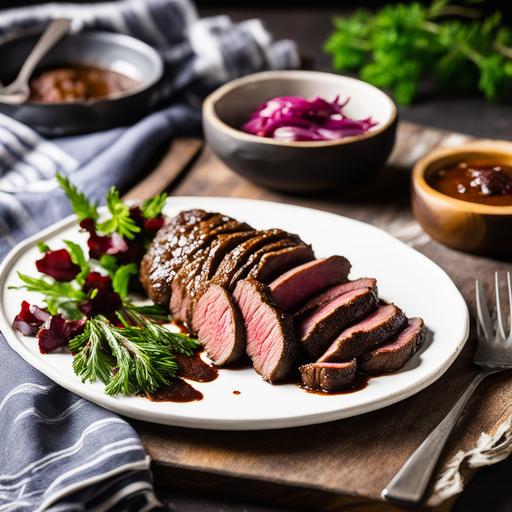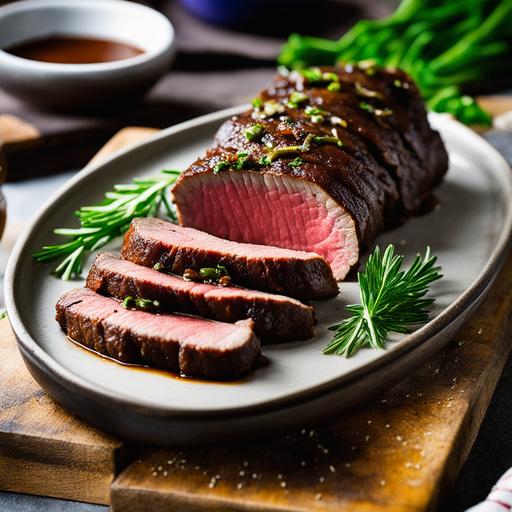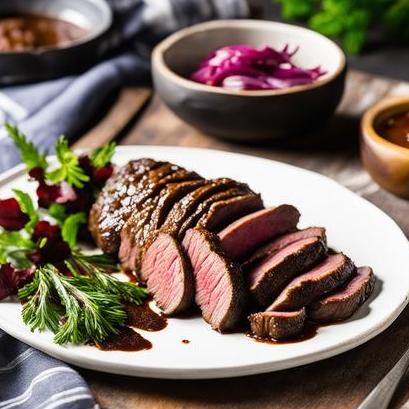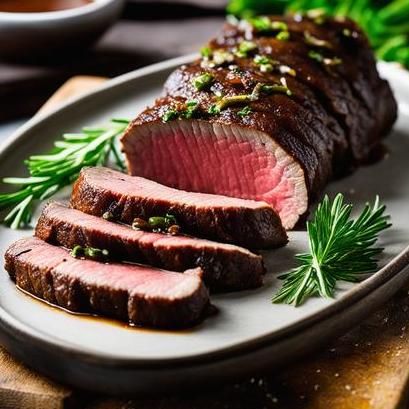
Venison Backstrap Oven Recipe: A Comprehensive Guide
Are you a fan of lean and succulent meat? Then venison backstrap is the ideal choice for you! This tender cut of deer meat, also known as "loin" or "tenderloin," is perfect for creating a mouth-watering meal that will impress even the most discerning palates. In this in-depth article, we will explore the world of venison backstrap and guide you through every step of a delicious venison backstrap oven recipe. From selecting the best cut to preparing and cooking it perfectly, we’ve got you covered!
The Science behind Venison Backstrap
Before delving into the culinary aspects, let’s understand the food science behind venison backstrap. Venison, being wild game meat, offers a unique flavor profile compared to its domestic counterparts. The backstrap, located along the deer’s spine, is exceptionally tender due to its low-fat content and minimal connective tissues. This translates into a delicate and melt-in-your-mouth texture.
The key to cooking venison backstrap to perfection lies in its leanness. Unlike other cuts of meat, backstrap can quickly become tough and dry if overcooked. But worry not, with the right techniques and tips, you can achieve a succulent and flavorful feast for your taste buds!
Selecting the Perfect Venison Backstrap
When choosing a venison backstrap, look for a cut that is deep red in color with a fine texture, indicating freshness. Avoid meat that appears dull or discolored, as it may be a sign of spoilage. It’s best to buy from a trusted source, such as a reputable butcher or a hunters’ market, to ensure quality.
Cleaning and Preparation

Before cooking, it is essential to clean and prepare the venison backstrap properly. Follow these steps for a pristine and appetizing piece of meat:
-
Trimming: Start by removing any visible silver skin or fat from the backstrap. This silver skin can create toughness in the meat if left intact.
-
Rinsing: Thoroughly rinse the backstrap under cold running water to remove any residual blood or impurities.
-
Pat Dry: Use a paper towel to pat the backstrap dry, ensuring no excess moisture remains on the surface.
It’s important to note that venison meat has a rather strong and distinct flavor, which can be intensified by excessive gaminess. To mellow out the taste, we highly recommend using a marinade. Marinating not only adds flavor but also helps tenderize the meat, making it more tender and juicy.
Marinating Tips and Flavors

Marinades play a vital role in enhancing the taste and texture of your venison backstrap. Consider the following tips and flavor profiles to create a winning marinade:
-
Acidic Components: Lemon juice, vinegar, or buttermilk are excellent choices for tenderizing the meat. The acid helps break down the muscle fibers, resulting in a more tender backstrap.
-
Sweet Elements: Honey, maple syrup, or brown sugar can balance out the gaminess and add a delightful caramelized touch to the exterior of the meat.
-
Herbs and Spices: Experiment with a variety of herbs like rosemary, thyme, or spices such as garlic powder, paprika, or cumin. These additions can infuse incredible flavors into the venison backstrap.
-
Oil: Olive oil, avocado oil, or vegetable oil can be included to retain moisture and prevent the meat from drying out during cooking.
Combine your desired ingredients in a plastic zip-top bag or a shallow dish, ensuring the marinade adequately coats the backstrap. Allow the venison to marinate for at least 2-4 hours or even overnight in the refrigerator for maximum flavor development.
Cooking Techniques for Venison Backstrap

The oven is an excellent tool for cooking venison backstrap, as it provides even heat distribution for a perfectly cooked piece of meat. Here’s a simple yet delicious recipe to prepare venison backstrap in the oven:
Oven-Roasted Venison Backstrap
Ingredients:
-
1 venison backstrap (approximately 1-1.5 pounds)
-
2 tablespoons of olive oil
-
Salt and pepper to taste
Instructions:
-
Preheat the oven: Preheat your oven to 400°F (200°C) and ensure your rack is placed in the center of the oven.
-
Searing the Meat: Heat a skillet over medium heat and add the olive oil. Once the oil begins to shimmer, gently place the backstrap in the pan. Sear each side for 2-3 minutes until a golden-brown crust forms.
-
Seasoning: Remove the backstrap from the skillet and generously season it with salt and pepper, ensuring an even coating on all sides.
-
Roasting: Place the seasoned backstrap on a wire rack set over a baking sheet to elevate it from any drippings. Roast in the preheated oven for approximately 10-15 minutes for medium-rare, or until the internal temperature reaches 130°F (55°C). Adjust the cooking time according to your desired level of doneness.
-
Resting: Once cooked to your liking, remove the backstrap from the oven and let it rest on a cutting board for 5-10 minutes. This step allows the juices to redistribute, resulting in a moist and flavorful meat.
-
Slicing and Serving: Slice the venison backstrap against the grain into medallions of your preferred thickness. Serve with your choice of sides, such as roasted vegetables, mashed potatoes, or a fresh salad, and enjoy!
Doneness Checks for Venison Backstrap

To ensure your venison backstrap reaches your desired level of doneness, it’s crucial to use an instant-read meat thermometer. Insert the thermometer into the thickest part of the meat without touching the bone or pan. Here are the recommended internal temperatures for different doneness levels:
-
Medium-Rare: 130°F (55°C) with a rosy pink center and slightly firm exterior.
-
Medium: 140°F (60°C) with a pink center and moderately firm exterior.
-
Medium-Well: 150°F (65°C) with a slightly pink center and firm exterior.
Keep in mind that the meat will continue to cook as it rests, so it’s essential to factor in this temperature rise when determining the desired doneness.
Variations and Additional Tips
Feel free to experiment with different variations and flavors to make your venison backstrap oven recipe truly unique. Here are some additional tips and ideas to consider:
-
Bacon-Wrapped Venison: For added indulgence and flavor, wrap the marinated backstrap with strips of bacon before roasting. The bacon fat bastes the meat, making it even more tender and the perfect treat for bacon lovers.
-
Fruit Compote: Pair the richness of venison backstrap with a tangy fruit compote. Create a syrupy reduction using berries, balsamic vinegar, and a touch of honey, complementing the meat’s natural flavors.
-
Grilling Option: If you prefer the smoky flavors imparted by grilling, you can adapt this recipe for a grill. Simply sear the backstrap on high heat for a couple of minutes per side, then move it to indirect heat and continue to cook until the desired internal temperature is reached.
Conclusion
Venison backstrap is a culinary delight that can elevate any meal to a whole new level. By understanding the science, selecting the perfect cut, and following the cleaning, preparation, and cooking techniques discussed in this article, you’ll be well-equipped to create a mouthwatering dish that will impress even the most discerning taste buds. So, grab your apron, marinate your backstrap, fire up the oven, and get ready to savor the delectable flavors of venison backstrap. Happy cooking and bon appétit!


